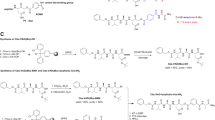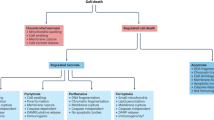Abstract
The protease responsible for the cleavage of poly(ADP-ribose) polymerase and necessary for apoptosis has been purified and characterized. This enzyme, named apopain, is composed of two subunits of relative molecular mass (Mr) 17K and 12K that are derived from a common proenzyme identified as CPP32. This proenzyme is related to interleukin-lβ-converting enzyme (ICE) and CED-3, the product of a gene required for programmed cell death in Caenorhabditis elegans. A potent peptide aldehyde inhibitor has been developed and shown to prevent apoptotic events in vitro, suggesting that apopain/CPP32 is important for the initiation of apoptotic cell death.
This is a preview of subscription content, access via your institution
Access options
Subscribe to this journal
Receive 51 print issues and online access
$199.00 per year
only $3.90 per issue
Buy this article
- Purchase on Springer Link
- Instant access to full article PDF
Prices may be subject to local taxes which are calculated during checkout
Similar content being viewed by others
References
Kerr, J. F., Wyllie, A. H. & Currie, A. R. Br. J. Cancer 26, 239–257 (1972).
Martin, S. J., Green, D. R. & Cotter, T. G. Trends biochem. Sci. 19, 26–30 (1994).
Barr, P. J. & Tomei, L. D. Biotechnology 12, 487–493 (1994).
Carson, D. A. & Ribeiro, J. M. Lancet 341, 1251–1254 (1994).
Ellis, R. E., Yuan, J. & Horvitz, H. R. A. Rev. Cell Biol. 7, 663–698 (1991).
Yuan, J., Shaham, S., Ledoux, S., Ellis, J. M. & Horvitz, J. R. Cell 75, 641–652 (1993).
Thornberry, N. A. et al. Nature 356, 768–774 (1992).
Cerretti, D. P. et al. Science 256, 97–100 (1992).
Miura, M., Zhu, H., Rotello, R., Hartwieg, E. A. & Yuan, J. Cell 78, 653–660 (1993).
Gagliardini, V. et al. Science 263, 826–828 (1994).
Juarez-Salinas, H., Sims, J. L. & Jacobson, M. K. Nature 282, 740–741 (1979).
Berger, N. A., Sikorski, G. W., Petzold, S. J. & Kurohara, K. K. Biochemistry 19, 289–293 (1980).
Satoh, M. S. & Lindahl, T. Nature 356, 356–358 (1992).
Ding, R., Pommier, Y., Kang, V. H. & Smulson, M. J. biol. Chem. 267, 12804–12812 (1992).
Smulson, M., Istock, N., Ding, R. & Cherney, B. Biochemistry 33, 6186–6194 (1994).
Ding, R. & Smulson, M. Cancer Res. 54, 4627–4634 (1994).
Burkle, A., Grube, K. & Küpper, J.-H. Expl clin. Immunogenet. 9, 230–240 (1992).
Wang, Z. Q. et al. Genes Dev. 9, 509–520 (1995).
Kaufmann, S. H., Desnoyers, S., Ottaviano, Y., Davidson, N. E. & Poirier, G. G. Cancer Res. 53, 3976–3985 (1993).
Lazebnik, Y. A., Kaufmann, S. H., Desnoyers, S., Poirier, G. G. & Earnshaw, W. C. Nature 371, 346–347 (1994).
Yoshihara, K., Tanigawa, Y. & Koide, S. S. Biochem. biophys. Res. Commun. 59, 658–665 (1974).
Yoshihara, K., Tanigawa, Y., Burzio, L. & Koide, S. S. Proc. natn. Acad. Sci. U.S.A. 72, 289–293 (1975).
Tanaka, Y., Yoshihara, K., Itaya, A., Kamiya, T. & Koide, S. S. J. biol. Chem. 259, 6579–6585 (1984).
Kumar, S., Kinoshita, M., Noda, M., Copeland, N. G. & Jenkins, N. A. Genes Dev. 8, 1613–1626 (1994).
Wang, L., Miura, M., Bergeron, L., Zhu, J. & Yuan, J. Cell 78, 739–750 (1994).
Fernandes-Alnemri, T., Litwack, G. & Alnemri, E. S. J. biol. Chem. 269, 30761–30764 (1994).
Munday, N. A. et al. J. biol. Chem. 270, 15870–15876 (1995).
Williams, M. S. & HenKart, P. A. J. Immun. 153, 4247–4255 (1994).
Heusel, J. W., Wesselschmidt, R. L., Shresta, S., Russell, J. H. & Ley, T. J. Cell 76, 977–987 (1994).
Li, P. et al. Cell 80, 401–411 (1995).
Kuida, K. et al. Science 267, 2000–2003 (1995).
Enari, M., Hug, H. & Nagata, S. Nature 375, 78–81 (1995).
Los, M. et al. Nature 375, 81–83 (1995).
Ayala, J. M. et al. J. Immun. 153, 2592–2599 (1994).
Ray, C. A. et al. Cell 69, 597–604 (1992).
Howard, A. D. et al. J. Immun. 154, 2321–2332 (1995).
Wilson, K. P. et al. Nature 370, 270–275 (1994).
Walker, N. P. C. et al. Cell 78, 343–352 (1994).
Westerik, J. O. & Wolfenden, R. J. biol. Chem. 247, 8195–8197 (1972).
Solary, E., Bertrand, R., Kohn, K. W. & Pommier, Y. Blood 81, 1359–1368 (1993).
Lazebnik, Y. A., Cole, S., Cooke, C. A., Nelson, W. G. & Earnshaw, W. C. J. Cell Biol. 123, 7–22 (1993).
deMurcia, G., Ménissier-deMurcia, J. & Schreiber, V. BioEssays 13, 455–462 (1991).
Langlois, A. J., Lapis, K., Ishizaki, R., Beard, J. W. & Bolognesi, D. P. Cancer Res. 34, 1457–1464 (1974).
Cherney, B. W. et al. Proc. natn. Acad. Sci. U.S.A. 84, 8370–8374 (1987).
Chapman, K. T. Bioorg. Med. Chem. Lett. 2, 613–618 (1992).
Miller, D. K. et al. J. biol. Chem. 268, 18062–18069 (1993).
Devereux, J., Haeberli, P. & Smithies, O. Nucleic Acids Res. 12, 387–395 (1984).
Morrison, J. F. Trends biochem. Sci. 7, 102–105 (1982).
Author information
Authors and Affiliations
Rights and permissions
About this article
Cite this article
Nicholson, D., Ali, A., Thornberry, N. et al. Identification and inhibition of the ICE/CED-3 protease necessary for mammalian apoptosis. Nature 376, 37–43 (1995). https://doi.org/10.1038/376037a0
Received:
Accepted:
Issue Date:
DOI: https://doi.org/10.1038/376037a0
This article is cited by
-
Comparative effects of various running exercise modalities on femoral bone quality in rats
European Journal of Applied Physiology (2024)
-
Synergistic lethality in chronic myeloid leukemia – targeting oxidative phosphorylation and unfolded protein response effectively complements tyrosine kinase inhibitor treatment
BMC Cancer (2023)
-
Independent role of caspases and Bik in augmenting influenza A virus replication in airway epithelial cells and mice
Virology Journal (2023)
-
Haspin balances the ratio of asymmetric cell division through Wnt5a and regulates cell fate decisions in mouse embryonic stem cells
Cell Death Discovery (2023)
-
The EZH2-H3K27me3 axis modulates aberrant transcription and apoptosis in cyclophosphamide-induced ovarian granulosa cell injury
Cell Death Discovery (2023)
Comments
By submitting a comment you agree to abide by our Terms and Community Guidelines. If you find something abusive or that does not comply with our terms or guidelines please flag it as inappropriate.



